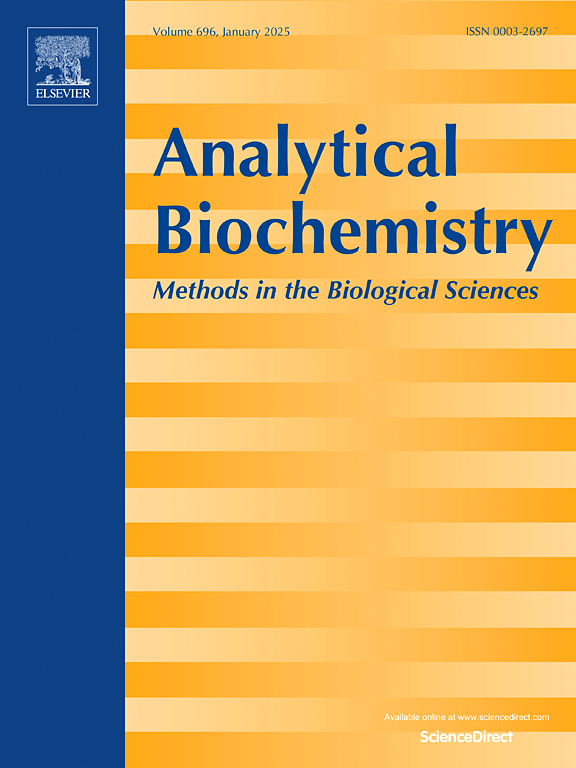Peptidomic and proteomic analysis of precision-cut lung slice supernatants
IF 2.5
4区 生物学
Q2 BIOCHEMICAL RESEARCH METHODS
引用次数: 0
Abstract
The precision-cut lung slice (PCLS) model is an ex vivo tissue system that has been used to model disease and examine the effects of exogenous compounds. Few studies have been carried out on the complement of proteins (proteome) and peptides (peptidome) secreted by PCLS and other tissue sections, during tissue culture, although such data are likely to provide critical information on the biology of tissue slices and the changes these undergo. In this study, a workflow was developed to examine the peptidome and proteome of PCLS supernatants using a modified single-pot, solid-phase-enhanced sample preparation (SP3) workflow. The performance of the SP3 workflow was evaluated in a head-to-head comparison against ultrafiltration by quantifying the recovery of synthetic peptide constructs. The SP3 workflow outperformed ultrafiltration in terms of recovery of small synthetic peptides regardless of the organic solvent used in SP3 (acetone or acetonitrile) and ultrafiltration molecular mass cut-off (2 or 10 kDa). The developed SP3 workflow provided robust data when analyzing PCLS supernatants across different conditions. The method allows, within a single workflow from individual samples, the identification of both large numbers of different native peptides (489) and also proteins (370) released from the tissue to the supernatants. This approach therefore has the capacity to provide both broad and in-depth peptidome and proteome data, with potential wide applicability to analyze the secretome of cultured tissue samples.

精切肺切片上清的肽组学和蛋白质组学分析。
精确切割肺切片(PCLS)模型是一种离体组织系统,已被用于模拟疾病和检查外源性化合物的影响。在组织培养过程中,对PCLS和其他组织切片分泌的蛋白质(蛋白质组)和肽(肽球)的补体进行的研究很少,尽管这些数据可能为组织切片的生物学及其所经历的变化提供关键信息。在本研究中,开发了一种工作流程,使用改进的单锅固相增强样品制备(SP3)工作流程来检测PCLS上清的肽球和蛋白质组。SP3工作流程的性能通过量化合成肽结构的回收率与超滤进行了头对头的比较。无论SP3中使用的有机溶剂(丙酮或乙腈)和超滤分子质量截止值(2或10 kDa)如何,SP3工作流程在小合成肽的回收方面都优于超滤。开发的SP3工作流在分析不同条件下的PCLS上清液时提供了可靠的数据。该方法允许在单个样品的单一工作流程内,鉴定大量不同的天然肽(489)和从组织释放到上清液的蛋白质(370)。因此,这种方法有能力提供广泛而深入的肽和蛋白质组数据,具有分析培养组织样本分泌组的潜在广泛适用性。
本文章由计算机程序翻译,如有差异,请以英文原文为准。
求助全文
约1分钟内获得全文
求助全文
来源期刊

Analytical biochemistry
生物-分析化学
CiteScore
5.70
自引率
0.00%
发文量
283
审稿时长
44 days
期刊介绍:
The journal''s title Analytical Biochemistry: Methods in the Biological Sciences declares its broad scope: methods for the basic biological sciences that include biochemistry, molecular genetics, cell biology, proteomics, immunology, bioinformatics and wherever the frontiers of research take the field.
The emphasis is on methods from the strictly analytical to the more preparative that would include novel approaches to protein purification as well as improvements in cell and organ culture. The actual techniques are equally inclusive ranging from aptamers to zymology.
The journal has been particularly active in:
-Analytical techniques for biological molecules-
Aptamer selection and utilization-
Biosensors-
Chromatography-
Cloning, sequencing and mutagenesis-
Electrochemical methods-
Electrophoresis-
Enzyme characterization methods-
Immunological approaches-
Mass spectrometry of proteins and nucleic acids-
Metabolomics-
Nano level techniques-
Optical spectroscopy in all its forms.
The journal is reluctant to include most drug and strictly clinical studies as there are more suitable publication platforms for these types of papers.
 求助内容:
求助内容: 应助结果提醒方式:
应助结果提醒方式:


